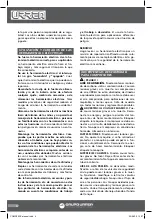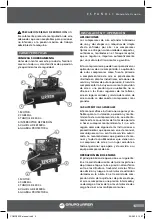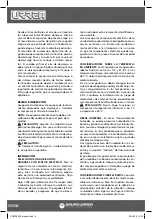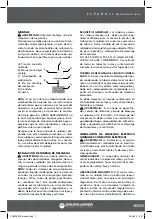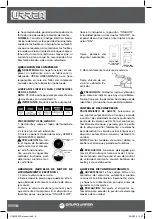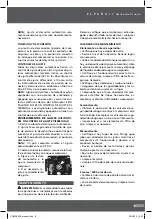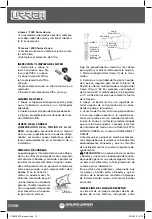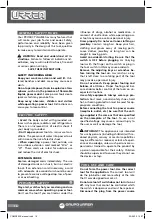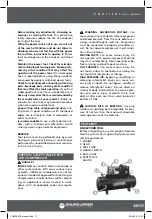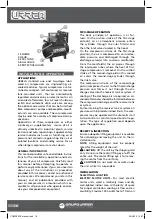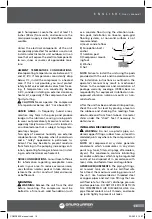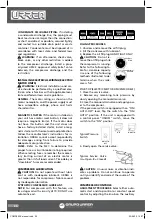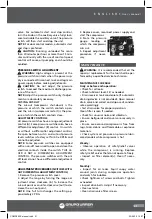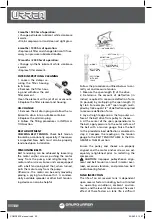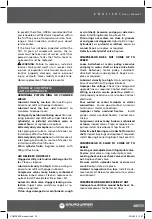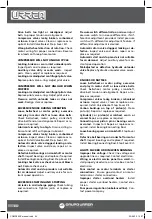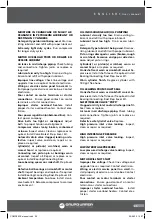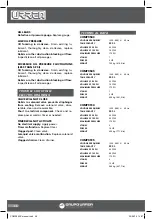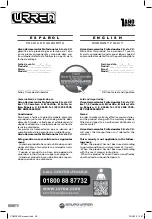
18
1. ENGINE.
2. HEAD.
3. 300 L TANK.
4. BALL VALVE.
5. PROTECTIVE GUARD.
INSTALLATION & OPERATION
APPLICATIONS
URREA’s standard one and two-stage lubri-
cated air compressors are single-acting, air-
cooled machines. Typical compressors are fur-
nished as compact, self-contained, air receiver
tank mounted units that are automatically
regulated and driven by an electric motor. An
air-cooled aftercooler, low oil level shutdown
switch and automatic drain valve are among
the optional accessories that can be furnished.
Bare compressor pumps and baseplate-mount-
ed units are also available. These compressors
may be used for a variety of compressed air ap-
plications.
Application of these compressors as either
a primary or supplementary source of air is
virtually unlimited in industrial plants, service
stations and auto repair shops. Supplementary
service includes such uses as furnishing air at
pressure not carried in regular shop lines, air at
isolated locations, and standby service for air
when larger compressors are shut down.
GENERAL INFORMATION
This manual provides safe and reliable instruc-
tions for the installation, operation and main-
tenance of your air compressor. Carefully read
this manual before attempting to operate or
perform any maintenance. If you are uncertain
about any of the instructions or procedures
provided in this manual, contact an authorized
service center. We recommend you retain this
manual, and all publications provided with
your air compressor, in a location which is ac-
cessible to all personnel who operate and ser-
vice your compressed air equipment.
TWO-STAGE OPERATION
The basic principle of operation is as fol-
lows: On the suction stroke of the first-stage
piston(s), air at atmospheric pressure enters
the cylinders through the inlet filter(s) and
then the inlet valves located in the head.
On the compression stroke of the first-stage
piston(s), the air is compressed to an interme-
diate pressure and discharged through the
discharge valves(s) into common manifold(s).
From the manifold(s) the air passes through
the intercooler tubes, where the heat of first-
stage compression is removed. On the suction
stroke of the second-stage piston this cooled
air enters the second-stage cylinder through
the inlet valve.
The compression stroke of the second-stage
piston compresses the air to the final discharge
pressure and forces it out through the dis-
charge valve into the receiver tank or system. If
cooling of the discharge air is required, an air-
cooled aftercooler should be installed between
the compressor discharge and the receiver tank
or system.
For maintaining the receiver tank or system air
pressure within predetermined limits, the com-
pressor may be operated with automatic start
& stop control or constant speed control regu-
lation. The type of regulation used depends
upon the application.
RECEIPT & INSPECTION
Ensure adequate lifting equipment is available
for unloading and moving the unit to the in-
stallation site.
NOTE: Lifting equipment must be properly
rated for the weight of the unit.
CAUTION: Lift the unit by the shipping skid
only. Do not use the motor lifting eye to lift the
entire unit. The motor lifting eye is for remov-
ing the motor from the unit only.
CAUTION! Do not work on or walk under
the unit while it is suspended.
INSTALLATION
SELECTING A LOCATION.
ELECTRIC MOTOR UNITS. For most electric
motor units, select a relatively clean and dry
well-lighted indoor area with plenty of space
for proper ventilation, cooling air flow and ac-
cessibility. Provide 1,000 cubic feet of fresh air
1
2
3
4
5
COMP95XX manual.indd 18
23/06/15 14:27

